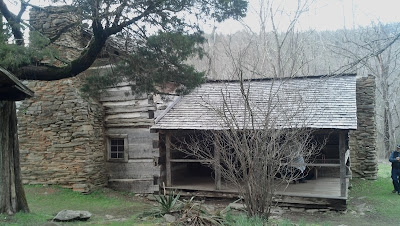The brochure identifies locations where specific buildings or activities were once located and where now there are only trees. The writer paints a colorful picture of the methods used to clear cut these hillsides, which rise and drop off at angles that are so steep you would think no animal or machine could manage an assent, let alone remove more than an estimated billion board feet of lumber over three decades.
The hiking trail continues from the end of the old railroad line. On this section of the river there is one waterfall after another, each more spectacular than the last.
Impressive rock outcroppings.
Moss and fern give the impression of cool and damp even in summer.
Marlin could not resist a waterfall video to capture the roaring level of the sound. Great hike that day.
On another day, our new book "History Hikes of the Smokies" provided us with great background about the Greenbrier School and the Walker homestead. This Little Brier Gap Trail was an easy three mile hike along a closed gravel road, passing the school house and ending at the only cabins remaining from the large Greenbrier community.
A simple log building served as the school house for more than 50 years. Official classes ended in 1935, however, the school is still used as a location to teach local students about life in the Smokey Mountains during the eighteen hundred's and early ninteen hundred's.
This "black board" is actually just that - boards painted black.
The school, built in 1882, of tulip tree boards so wide only five are needed for each side.
A nice comfy seat after walking many miles to school in winter weather!
Continuing on another mile to the Walker homestead, the first building visible is the spring house where milk, butter, and other perishables were kept cold in the summer by storing them on rocks placed in the cold spring water.
Fresh cold water flows from a spring under this building.
The spring house. Even though no family has lived here for many years, there is still evidence the place was once loved and cared for. Vinca, lilacs, daffodils, privet hedges, and other plantings continue to thrive all around the property.
A view of the back of the house. The one story section was built in 1850, the two story section was added when the family grew to eleven children. John Walker and his wife Margaret Jane were remarkably self-sufficient, even by the standards of their day. John was blacksmith, leather craftsman, ran a gristmill, built furniture, all in addition to tending an orchard, sheep, cows, and mules. Margaret was a herbalist and midwife, as well as raising all eleven children to adulthood.
The corn crib, with roof extensions for storing tools and equipment.
One reason the Walker homestead remains today is because of the story of five of the Walker children. The boys in the family grew up, married and moved away. One sister married, but the five other girls, Margaret Jane, Mary Elizabeth (Polly), Martha Ann, Louisa Susan and Hettie Rebecca, remained at home.
When the Great Smokey National Park was established in 1934 the five sisters, who were by then committed spinsters, still operated the farm as it had always been run. The National Park service, having bought out all other inhabitants within the new park boundaries, gave these women a life lease so they could live in their home for the rest of their lives. The last sister, Louisa, passed away in 1964.
The History Hikes book mentions an article about the Walker sisters in the Saturday Evening Post in 1946. It's worth googling the link as it paints a more complete picture of their life and includes photos. Marlin found the article "Time Stood Still In the Smokies" by John Maloney by looking up the Saturday Evening Post archives.
Great day, great hike, great visit to the Smokies (again). We'll be back.
.

















No comments:
Post a Comment